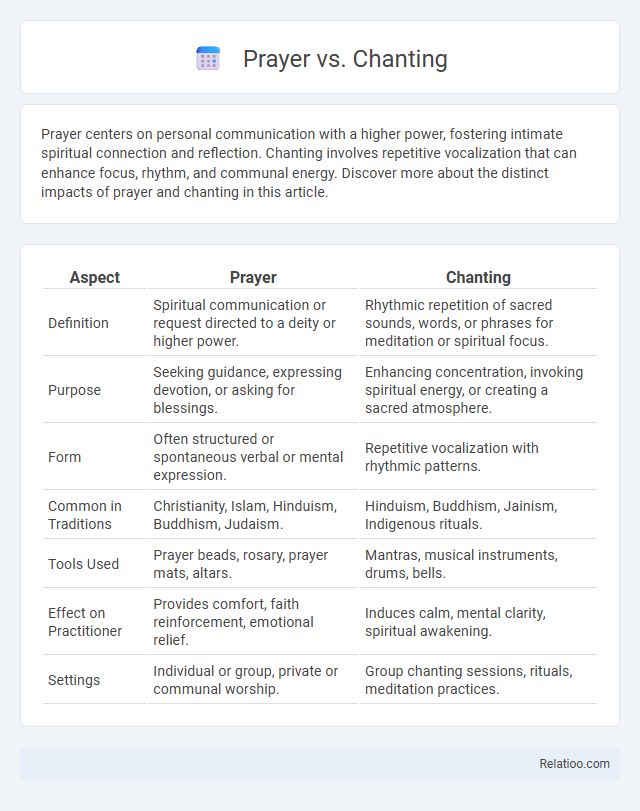Prayer centers on personal communication with a higher power, fostering intimate spiritual connection and reflection. Chanting involves repetitive vocalization that can enhance focus, rhythm, and communal energy. Discover more about the distinct impacts of prayer and chanting in this article.
Table of Comparison
| Aspect | Prayer | Chanting |
|---|---|---|
| Definition | Spiritual communication or request directed to a deity or higher power. | Rhythmic repetition of sacred sounds, words, or phrases for meditation or spiritual focus. |
| Purpose | Seeking guidance, expressing devotion, or asking for blessings. | Enhancing concentration, invoking spiritual energy, or creating a sacred atmosphere. |
| Form | Often structured or spontaneous verbal or mental expression. | Repetitive vocalization with rhythmic patterns. |
| Common in Traditions | Christianity, Islam, Hinduism, Buddhism, Judaism. | Hinduism, Buddhism, Jainism, Indigenous rituals. |
| Tools Used | Prayer beads, rosary, prayer mats, altars. | Mantras, musical instruments, drums, bells. |
| Effect on Practitioner | Provides comfort, faith reinforcement, emotional relief. | Induces calm, mental clarity, spiritual awakening. |
| Settings | Individual or group, private or communal worship. | Group chanting sessions, rituals, meditation practices. |
Understanding Prayer and Chanting: Key Differences
Prayer involves direct communication with a deity or higher power, focusing on expressing faith, gratitude, or requests, while chanting uses repetitive sounds or phrases to induce a meditative or spiritual state. Your understanding deepens by recognizing that prayer is often a personalized dialogue, whereas chanting emphasizes rhythm and vibration to align the mind and body. Both practices play unique roles in spiritual growth, offering distinct pathways to connection and mindfulness.
Historical Origins of Prayer and Chanting
Prayer and chanting both have ancient origins, with prayer often traced back to early human attempts to communicate with divine forces in Mesopotamian and Egyptian civilizations around 3000 BCE. Chanting, with roots in Vedic traditions of India circa 1500 BCE, involved repetitive vocalization of sacred sounds or mantras to invoke spiritual energy and facilitate meditation. While prayer typically involves direct supplication or thanksgiving to deities, chanting serves as a rhythmic, meditative practice designed to focus the mind and connect with transcendent realities.
Spiritual Significance of Prayer
Prayer holds profound spiritual significance as a direct, heartfelt communication between you and a higher power, fostering deep personal connection and inner peace. Unlike chanting, which often involves repetitive sounds or mantras to induce meditative states, prayer emphasizes sincere expression of faith, gratitude, and supplication. This intimate practice reinforces spiritual growth, emotional healing, and a sense of divine presence in your life.
The Role of Chanting in Various Traditions
Chanting serves as a powerful spiritual practice across diverse religious traditions, including Hinduism, Buddhism, and Christianity, where it is used to focus the mind and invoke divine presence. Unlike silent prayer, chanting often involves repetitive vocalization of sacred sounds or mantras that create a meditative rhythm enhancing your spiritual connection and emotional well-being. This repetitive vocal practice supports deep concentration, communal harmony, and the transmission of spiritual wisdom through sound vibrations.
Methods and Practices of Prayer
Methods and practices of prayer involve personal communication with a higher power through spoken words, silent reflection, or meditative focus. Chanting uses repetitive vocalization of specific sounds or phrases to induce a spiritual state, often synchronized with breath control and rhythm. Your prayer practice can integrate these methods to deepen spiritual experience and foster a stronger connection with divinity.
Techniques and Benefits of Chanting
Chanting involves repetitive vocalization of specific sounds, words, or phrases, promoting deep concentration and a meditative state that can reduce stress and increase mental clarity. Unlike traditional prayer, which often focuses on petition or gratitude directed toward a deity, chanting emphasizes rhythm and vibration, enhancing emotional balance and spiritual connection through sound frequencies. Your practice of chanting can improve respiratory function, stimulate neural pathways, and foster a profound sense of inner peace and mindfulness.
Psychological Effects: Prayer vs Chanting
Prayer and chanting both foster psychological well-being but engage the mind differently; prayer often induces a reflective and soothing mental state by encouraging personal communication with a higher power, while chanting promotes rhythmic repetition that can enhance focus and induce a meditative trance. You may experience reduced stress and increased emotional stability through prayer's introspective nature, whereas chanting can improve cognitive function and create a sense of community through synchronized vocalization. Understanding these distinct psychological effects helps in choosing a practice that aligns with your emotional and mental health goals.
Prayer and Chanting in Community Settings
Prayer and chanting in community settings foster collective spiritual connection and emotional support, enhancing the shared experience through synchronized voices and intentions. Your participation in communal prayer promotes unity and reinforces shared beliefs, while chanting often utilizes rhythmic patterns to deepen focus and group cohesion. Both practices serve as powerful tools for cultivating mindfulness and a sense of belonging among participants.
Comparative Benefits: Which One Suits You?
Prayer fosters personal connection with a higher power, enhancing spiritual intimacy and emotional support, while chanting uses repetitive sounds or phrases to induce meditative states and improve mental clarity. Meditation centers on mindfulness and present awareness, reducing stress and promoting overall well-being. Choosing between prayer, chanting, or meditation depends on whether you seek spiritual communion, mental focus, or stress relief.
Integrating Prayer and Chanting into Daily Life
Integrating prayer and chanting into your daily life enhances mindfulness and spiritual connection by combining intentional communication with rhythmic repetition. Prayer allows personalized expression of gratitude and requests, while chanting uses repetitive sounds or phrases that can induce meditative states and reduce stress. Incorporating both practices throughout your day supports emotional balance and deepens your overall well-being.

Infographic: Prayer vs Chanting
 relatioo.com
relatioo.com